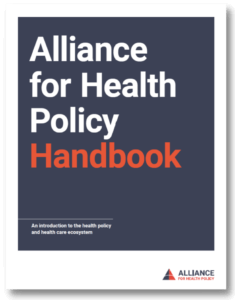Resources

Health Policy Handbook
At the Alliance, we believe a better health care system begins with a balanced exchange of evidence, experience, and multiple perspectives. To achieve this mission, we strive to educate and prepare the next generation of health policy leaders through collaborative learning and conversation.
The Health Policy Handbook is designed to serve as a primer for congressional, executive branch and support agency staff, journalists, and others who are interested in a quick-study of the key foundations of health policy. This Handbook features a collection of six chapters, each devoted to one core health policy topic and supplemented by extensive resource lists.
Discover Topics
The Alliance takes a “listening first'' approach, gathering insights from the health policy community and health care stakeholders to clarify and synthesize current issues and create a forum for dialogue to advance the conversation for improving health and health care in the United States.
In the Spotlight
An equitable health care system is one in which everyone has a fair and just opportunity to attain their highest level of health. While academic research on matters of health equity spans decades, the challenge of addressing inequity in the health care system has been increasingly front and center for policymakers in recent years.
Mental health is a dynamic state of internal equilibrium which enables individuals to use their abilities in harmony with universal values of society. Basic cognitive and social skills; ability to recognize, express and modulate one’s own emotions, as well as empathize with others; flexibility and ability to cope with adverse life events and function in social roles; and harmonious relationship between body and mind represent important components of mental health which contribute, to varying degrees, to the state of internal equilibrium.
Public health promotes and protects the health of people and the communities where they live, learn, work and play. Prevention is defined as actions aimed at eradicating, eliminating or minimizing the impact of disease and disability.
Resources For You
Policymakers
Members of Congress, Congressional and agency staff, federal, state, and local legislators.
Health Care Stakeholders
Industry stakeholders, practitioners and providers, patient advocates, community organizations, academics.
Media
Members of the press, journalists, public relations professionals.
Toolkits
Toolkits on health policy topics in the news, providing background information, a summary of the latest developments, and resources for further reading.
Sourcebook
The entire Alliance for Health Policy staff and our capable interns contributed to this edition the Sourcebook. We also thank the experts from the health policy community who contributed their vast knowledge.
Glossary
Contact Us
Contact info@allhealthpolicy.org for any inquiries.


